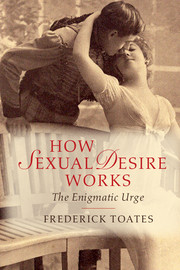Book contents
- Frontmatter
- Dedication
- Contents
- List of figures
- Preface
- One What is enigmatic about sexual desire?
- Two Explaining desire: multiple perspectives
- Three Sexual desire in a broad context
- Four An incentive-based model
- Five Sex and levels of organization
- Six Sexual attraction
- Seven Shades of desire from simple to complex
- Eight Details of the brain and desire
- Nine Arousal
- Ten The consequences of sexual behaviour and associated expectations
- Eleven Sexual familiarity and novelty
- Twelve Inhibition, conflict and temptation
- Thirteen How did sexual desire get here?
- Fourteen Setting the trajectory: link to adult sexuality
- Fifteen Sexual desire in interaction
- Sixteen Representations of sex
- Seventeen Sexual addiction
- Eighteen Variations in desire: general principles
- Nineteen Some forms of desire at the fringes
- Twenty The toxic fusion: violence and sexual desire
- Twenty one Sexually associated (serial) murder
- Twenty two Concluding remarks
- Notes
- References
- Index
Five - Sex and levels of organization
Published online by Cambridge University Press: 05 October 2014
- Frontmatter
- Dedication
- Contents
- List of figures
- Preface
- One What is enigmatic about sexual desire?
- Two Explaining desire: multiple perspectives
- Three Sexual desire in a broad context
- Four An incentive-based model
- Five Sex and levels of organization
- Six Sexual attraction
- Seven Shades of desire from simple to complex
- Eight Details of the brain and desire
- Nine Arousal
- Ten The consequences of sexual behaviour and associated expectations
- Eleven Sexual familiarity and novelty
- Twelve Inhibition, conflict and temptation
- Thirteen How did sexual desire get here?
- Fourteen Setting the trajectory: link to adult sexuality
- Fifteen Sexual desire in interaction
- Sixteen Representations of sex
- Seventeen Sexual addiction
- Eighteen Variations in desire: general principles
- Nineteen Some forms of desire at the fringes
- Twenty The toxic fusion: violence and sexual desire
- Twenty one Sexually associated (serial) murder
- Twenty two Concluding remarks
- Notes
- References
- Index
Summary
The heart has its reasons of which reason knows nothing.
(Pascal, 1669/1996, pensée no. 423)Charms would not deserve their name if they did not have the power to silence our reason.
(Casanova, 1798/1958, p. 246)Having advanced the case for an incentive motivation model of sex, it is necessary to fit this idea to the notion of levels of organization, exemplified by automatic and controlled processing (Chapter 2).
Evidence points to behaviour being determined by at least two levels of control in the brain (Carver et al., 2009; LeDoux, 1999; Toates, 1998, 2006):
an evolutionarily old low-level system, which is (‘automatically’) reactive to specific events in the world. It can sometimes operate at an unconscious level;
an evolutionarily new high-level (‘controlled’) system that operates at a conscious level and seeks long-term rational goals (e.g. to maintain marital harmony, resist temptation).
The levels of organization can act in the same direction (e.g. both tending to trigger behaviour) or in opposition (e.g. low level excites behaviour, while high level tends to restrain).
- Type
- Chapter
- Information
- How Sexual Desire WorksThe Enigmatic Urge, pp. 112 - 127Publisher: Cambridge University PressPrint publication year: 2014

